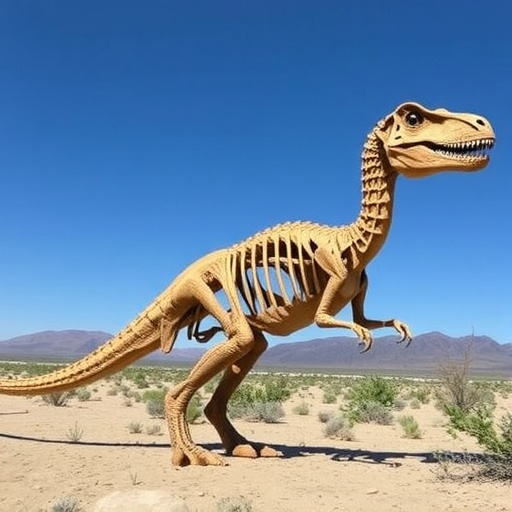New geochronological evidence from the Naashoibito Member of the Kirtland Formation in northern New Mexico reveals an essential revision to our understanding of dinosaur diversity and extinction patterns in the waning days of the Cretaceous Period. Previously, paleontologists have struggled to resolve whether non-avian dinosaurs faced a protracted decline before their sudden extinction at the Cretaceous-Paleogene (K-Pg) boundary 66 million years ago. The newly obtained precise uranium-lead (U-Pb) radiometric dates indicate that dinosaurs in this region thrived right up to the asteroid impact event, pushing back against longstanding hypotheses of gradual ecological collapse.
The study, led by Andrew Flynn and colleagues, expands the temporal framework for dinosaur fossil assemblages in western North America. By dating the Naashoibito Member to approximately 66.4 to 66.0 million years ago, the researchers establish concurrent timelines with the Hell Creek Formation farther north—a site long considered the standard for examining the final dinosaur ecosystems. This contemporaneity demonstrates that dinosaur populations across the western United States remained robust and regionally distinct as the Cretaceous drew to a close.
One significant implication of these findings challenges models suggesting a uniform Late Cretaceous ecosystemal decline. Instead, the data supports a scenario of pronounced provinciality, evidencing that dinosaur faunas were not only diverse but also adapted to localized environmental niches. These regional variations in dinosaur communities imply a complex ecological structure unperturbed by incremental environmental degradation, countering assumptions that ecosystem fragility preceded the mass extinction.
Analyses of the Naashoibito fossil assemblages underscore a spectrum of dinosaur sizes, dietary strategies, and taxonomic diversity persisting until the terminal Cretaceous. This spectrum includes large herbivorous hadrosaurs, predatory theropods, and other clades varying in morphology and behavior. The absence of discernible signs of declining population health or decreased biodiversity lends weight to the hypothesis that the ultimate eradication of non-avian dinosaurs was abrupt and catastrophic rather than gradual.
The new geochronological results were derived using state-of-the-art high-precision U-Pb dating techniques, which allowed the team to constrain the age of volcanic ash layers embedded within the sedimentary sequences. This methodological advancement mitigates previous uncertainties caused by imprecise stratigraphic correlations and radiometric dating errors, enabling more accurate reconstructions of faunal chronologies coincident with the K-Pg boundary.
Comparisons with fossil records from other continents, though less temporally resolved, suggest similarly persistent dinosaur communities surviving until the impact event. Such global concordance strengthens the interpretation that non-avian dinosaurs worldwide were neither universally declining nor extinguished by protracted stressors, but were instead victims of a sudden, planet-wide catastrophe.
This revelation has profound implications for understanding the dynamics of mass extinctions and the resilience of ancient ecosystems. It highlights that ecological complexity and evolutionary success did not inevitably decline prior to the asteroid impact and that abrupt external forces played the dominant role in the destruction of these iconic vertebrates.
Moreover, the study elucidates the significance of integrated multidisciplinary approaches combining precise geochronology, sedimentology, paleontology, and paleoecology. Such synthesis is pivotal in disentangling the multifaceted interactions governing extinction events and evolutionary turnovers through deep time.
The confirmation of high provinciality among late Cretaceous dinosaur faunas invites a reevaluation of biogeographic distribution patterns and interspecific interactions during this epoch. Understanding the environmental variables driving such diversification demands further investigation, especially regarding climatic gradients, habitat heterogeneity, and the influence of tectonic processes shaping the western North American landscape.
An accompanying perspective by Lindsay Zanno elaborates on these insights, examining the broader context of dinosaur ecology and extinction dynamics. This discourse emphasizes that recognizing the abrupt cessation of non-avian dinosaurs reframes narratives about their evolutionary decline and challenges interpretations relying heavily on biased or fragmentary fossil datasets.
In sum, Flynn et al.’s work decisively tilts the balance toward an extinction scenario dominated by a cataclysmic extraterrestrial impact as the immediate trigger for the disappearance of non-avian dinosaurs. It underscores the pivotal role of precise chronological control in paleontological research and revitalizes debates about how Earth’s biosphere responds to global environmental perturbations.
This study significantly broadens the spatial and temporal resolution of late Cretaceous dinosaur population data. It offers a refined lens through which scientists can examine the last chapters of dinosaur evolution, including their adaptive radiations, niche partitioning, and final vulnerability to mass extinction forces.
Ultimately, these findings contribute critical clarity to one of the most iconic extinction events in Earth’s history, reaffirming that even the most successful animal groups can be swiftly exterminated through sudden, high-magnitude disruptions, with little forewarning from their preceding ecological status.
Subject of Research: Late Cretaceous dinosaur diversity, extinction timing, and provinciality in North America
Article Title: Late-surviving New Mexican dinosaurs illuminate high end-Cretaceous diversity and provinciality
News Publication Date: 23-Oct-2025
Web References: https://doi.org/10.1126/science.adw3282
References: Flynn, A. et al. (2025). Late-surviving New Mexican dinosaurs illuminate high end-Cretaceous diversity and provinciality. Science.
Keywords: Dinosaur extinction, Cretaceous-Paleogene boundary, geochronology, U-Pb dating, paleoecology, provinciality, mass extinction, Naashoibito Member, Kirtland Formation, Hell Creek Formation, Late Cretaceous ecosystems, asteroid impact




